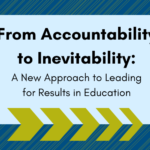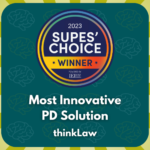School systems across the country have responded to the national reckoning around issues of racial justice by rapidly developing strategies and plans for education equity. These efforts are certainly better than no effort at all, but they miss a crucial point: an education system cannot have a strategy for equity. Equity needs to be the strategy for everything else.
This is not meant to minimize, in any respect, the extremely serious safety and logistical considerations involved in reopening schools during a global pandemic. But when equity is the “why,” the “how” and the “what,” it shines a light on the path forward during these challenging times. Before continuing, it is important to clarify that my definition of educational equity goes well beyond buzzword status, proclamations of the importance of equity by school boards, and the equity committee where everyone on the committee is super-committed to sharing how committed they are about equity.
thinkLaw’s Educational Equity Equation helps you to prioritize equity in your classroom by leveraging instruction rooted in critical thinking that will help your students to question the world around them and become agents of change. Click here to learn more.
Educational equity is a design framework where justice is the outcome for individual children and for the system as a whole. In practical terms, equity requires four fundamental shifts:
1. Moving away from the mythical idea of meeting the needs of “all students” to the student-centered approach of meeting the needs of “each child.”
2. Rejecting the notion of empowering students because students already have power, and equity requires the system to help students galvanize this power.
3. Recognizing that academic success, is a necessary, but insufficient outcome of an equitable education system.
4. Preparing students burdened by unjust systems to successfully navigate, question, dismantle, and rebuild new, more just systems.
For school system leaders grappling with COVID-19 reopening challenges, these four shifts can provide remarkable levels of clarity. We call this comprehensive approach The Educational Equity Equation, because true equity requires a combination of goals. When your focus is on “each child” instead of “all students,” your leadership becomes more purposeful and less colorblind. The transition to “each” means you are disaggregating the data. Focusing on “each” necessitates an equity-focused strategy to data collection to begin with, because when you already know devices and wifi access are a challenge for families, why would you ever rely on an 100% online family survey to guide your decision-making?
As Dr. Rosa Perez Isiah noted in our recent Educational Equity Equation Conversation, this is not really a battle between equity and hand sanitizer. Equity is hand sanitizer. Pre-pandemic, why was it ever normal to narrowly focus on academic success in schools without hot water, disgusting bathrooms, and poor ventilation systems? There is no question that the pandemic has heightened public awareness of inequities like the digital divide. An equity focus mandates the understanding that connectivity means more than a Chromebook and a hotspot.
How connected are students to grade-level work in a system that regularly underteaches low-income students of color? How much access do students have to the tools that prepare them to break the stuff that needs to be broken when we treat critical thinking like a luxury good? Disproportionately low identification rates for these students in gifted and talented and other advanced academic programs have been an issue as long as these programs have existed. Your school board’s #BlackLivesMatter statement is important. But if your school system’s day-to-day practices call into question whether Black minds matter, whether the voices, input, and know-how of Black families matter, or whether the injustice of asking Black students to work twice as hard to get half as far matters, there is still work to do to make equity actionable.
Student and teacher safety. Academic achievement. College and career readiness. Ensuring the basic needs of students are met. Yes, yes, and more yes to all of these. But equity cannot be just another item on the list if your school system is serious about repairing the injustices built into the system.










Leave a Reply